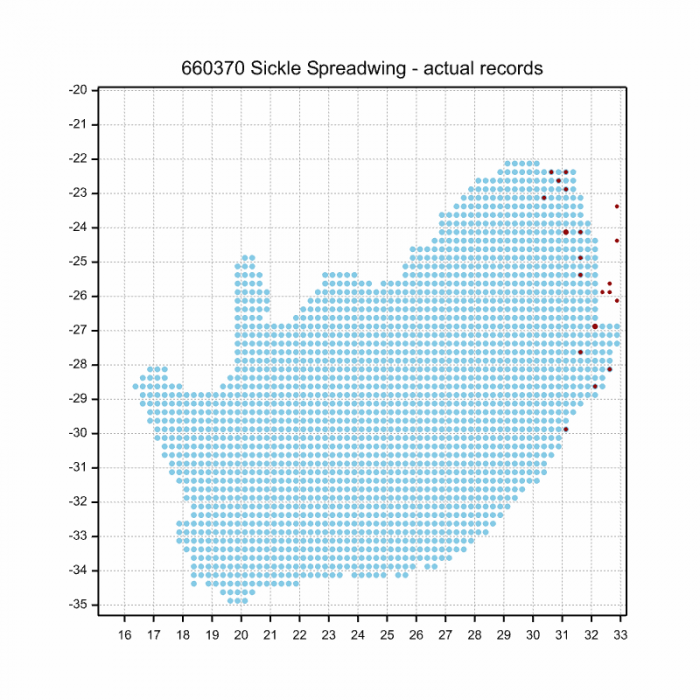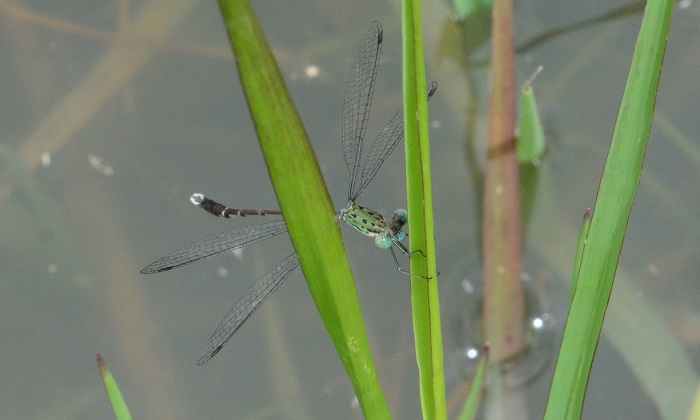Cover photo by John Wilkinson.
Find the Sickle Spreadwing in the FBIS database (Freshwater Biodiversity Information System) here.
Family Lestidae
Identification

Near Hluhluwe, KwaZulu-Natal
Photo by Ryan Tippett
Medium-large size
Length up to 48mm; Wingspan reaches 51mm.
The Sickle Spreadwing is easily recognised and unlike any other spreadwing in the region. Its large size and green, turquoise and brown colouration is distinctive. In males the obviously hooked, white claspers are diagnostic.
Females are similar to males but are duller and lack the distinctive white, hooked claspers.
Click here for more details on identification.

Near Hluhluwe, KwaZulu-Natal
Photo by Ryan Tippett
Habitat
The Sickle Spreadwing inhabits ponds, pools, and marshes. It prefers habitats with tall grass and sedges surrounded by dense bush. Lestes uncifer is restricted to low altitudes, mostly in humid, and well-wooded, or forested areas.

Photo by Ryan Tippett
Behaviour
The Sickle Spreadwing spends long periods hanging vertically from tall emergent plant stems. It is well camouflaged and is a shy and weary species that retreats into thick vegetation when disturbed. Females occur in the same vicinity as the males. The Sickle Spreadwing takes relatively large prey, including other damselfly species.

Near Hluhluwe, KwaZulu-Natal
Photo by Ryan Tippett
The Sickle Spreadwing is most active from late November to June, possibly all year at some sites. See Phenology below.
Status and Conservation
The Sickle Spreadwing is an uncommon and highly localised species. In South Africa, it is listed as Vulnerable in the IUCN Red List of Threatened Species. This is due to its scarcity and marginal occurrence in the country. The Sickle Spreadwing has a wider distribution in tropical Africa and is considered of Least Concern over the rest of its range. The Sickle Spreadwing is fairly sensitive to habitat degradation and is mostly found in undisturbed places. In some areas it will make use of small man-made ponds and dams, provided they offer good quality habitat.

Near Hluhluwe, KwaZulu-Natal
Photo by Ryan Tippett
Distribution
The Sickle Spreadwing is native to much of the southern and eastern parts of Africa, where it is widespread. It ranges from South Africa northwards to Kenya and Uganda. In South Africa, the Sickle Spreadwing is found in the lowveld regions of Limpopo and Mpumalanga, and the sub-tropical north-eastern parts of KwaZulu-Natal.
Below is a map showing the distribution of records for Sickle Spreadwing in the OdonataMAP database as at February 2020.

Below is a map showing the distribution of records for Sickle Spreadwing in the OdonataMAP database as of December 2024.

The next map below is an imputed map, produced by an interpolation algorithm, which attempts to generate a full distribution map from the partial information in the map above. This map will be improved by the submission of records to the OdonataMAP section of the Virtual Museum.


Ultimately, we will produce a series of maps for all the odonata species in the region. The current algorithm is a new algorithm. The objective is mainly to produce “smoothed” maps that could go into a field guide for odonata. This basic version of the algorithm (as mapped above) does not make use of “explanatory variables” (e.g. altitude, terrain roughness, presence of freshwater — we will be producing maps that take these variables into account soon). Currently, it only makes use of the OdonataMAP records for the species being mapped, as well as all the other records of all other species. The basic maps are “optimistic” and will generally show ranges to be larger than what they probably are.
These maps use the data in the OdonataMAP section of the Virtual Museum, and also the database assembled by the previous JRS funded project, which was led by Professor Michael Samways and Dr KD Dijkstra.
Phenology



Near Hluhluwe, KwaZulu-Natal
Photo by Ryan Tippett
Further Resources
The use of photographs by John Wilkinson is acknowledged. All other photographs by Ryan Tippett.
Sickle Spreadwing Lestes uncifer Karsch, 1899
Other common names: Sekelspanvlerkie (Afrikaans)
Recommended citation format: Loftie-Eaton M; Navarro R; Tippett RM; Underhill L. 2025. Sickle Spreadwing Lestes uncifer. Biodiversity and Development Institute. Available online at https://thebdi.org/2020/04/20/sickle-spreadwing-lestes-uncifer/
References: Tarboton, M; Tarboton, W. (2019). A Guide to the Dragonflies & Damselflies of South Africa. Struik Nature.
Samways, MJ. (2008). Dragonflies and Damselflies of South Africa. Pensoft
Samways, MJ. (2016). Manual of Freshwater Assessment for South Africa: Dragonfly Biotic Index. Suricata 2. South African National Biodiversity Institute, Pretoria

Near Hluhluwe, KwaZulu-Natal
Photo by Ryan Tippett

